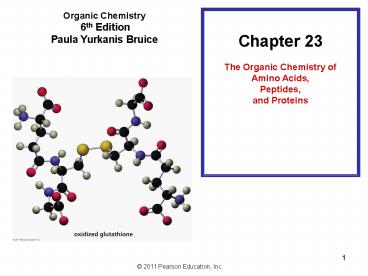23_Lecture.ppt PowerPoint PPT Presentation
1 / 59
Title: 23_Lecture.ppt
1
Organic Chemistry 6th Edition Paula Yurkanis
Bruice
Chapter 23 The Organic Chemistry of Amino
Acids, Peptides, and Proteins
2
Peptides and proteins are polymers of amino acids
linked together by amide bonds
3
Classification of Amino Acids
- Hydrophobic water-fearing, nonpolar side chains
- Alkyl side chain
- Hydrophilic water-loving side chains
- Polar, neutral side chains
- Anionic
- Cationic
4
Nonpolar Side Chains
5
Polar, Neutral Side Chains
6
Polar, Acidic Side Chains
7
Basic, Polar Side Chains
8
(No Transcript)
9
Configuration of Amino Acids
10
AcidBase Properties of Amino Acids
An amino acid can never exist as an uncharged
compound
11
(No Transcript)
12
Some amino acids have ionizable hydrogens on
their side chains
13
The isoelectric point (pI) of an amino acid is
the pH at which it has no net charge
14
The pI of an amino acid that has an ionizable
side chain is the average of the pKa values of
ionized groups of the same charge
15
A mixture of amino acids can be separated by
electrophoresis on the basis of their pI values
Ninhydrin is used to detect the individual amino
acids
16
(No Transcript)
17
A mixture of amino acids can also be separated on
the basis of polarity
18
Ion-exchange chromatography can be used to
perform preparative separation of amino acids
Negatively charged resin binds selectively to
positively charged amino acids
19
Ion-Exchange Chromatography
- Cations bind most strongly to cation-exchange
- resins.
- Anions bind most strongly to anion-exchange
- resins.
- An amino acid analyzer is an instrument that
automates - ion-exchange chromatography.
20
Synthesis of Amino Acids
HVZ reaction followed by reaction with ammonia
Reductive amination
21
A more efficient way of synthesizing amino acids
22
The Strecker Synthesis
23
Resolution of Racemic Mixtures of Amino Acids
24
Formation of a Peptide
25
A peptide bond has 40 double-bond character
26
Formation of Disulfide Bonds
Disulfides can be reduced to thiols
27
The disulfide bridge in proteins contributes to
the overall shape of a protein
28
(No Transcript)
29
Peptide Examples
ENKEPHALINS Natural ligands for opioid receptors
Tyr-Gly-Gly-Phe-Leu Tyr-Gly-Gly-Phe-Met
NUTRASWEET Peptide-based sweetener
GLUTATHIONE Antioxidant and electrophile trap
30
Because amino acids have two functional groups,
amide bond formation with a mixture of two amino
acids affords four products
31
Strategy for Making a Specific Peptide Bond
32
t-BOC protection of an amine group
The t-BOC protecting group is stable during amide
bond formation but is removed under acidic
conditions
33
Carboxylic acid activation by DCC
34
Amide bond formation
35
Amino acids can be added to the growing
C-terminal end by repeating these two steps
36
When the desired number of amino acids has been
added to the chain, the protecting group can be
removed
37
An Improved Peptide Synthesis Strategy
Attachment of N-protected amino acid to resin
38
Removal of t-BOC protecting group
Carboxylic acid activation of second amino acid
39
Amide bond formation
Removal of t-BOC protecting group
40
Carboxylic acid activation of N-terminal amino
acid
Amide bond formation
Removal of t-BOC protecting group
41
Release of tripeptide from Merrifield resin
42
Sequencing Proteins
- N-terminal amino acid?
- C-terminal amino acid?
- What is in between?
43
The first step in determining the sequence of
amino acids in a peptide or protein is to cleave
the disulfide bridges
44
The next step is to determine the number and
kinds of amino acids in the peptide or protein by
hydrolysis and then analysis of the mixture
45
The N-terminal amino acid of a peptide or a
protein can be determined by Edman degradation
46
The particular PTHamino acid can be identified
by chromatography using known standards
47
The C-terminal amino acid can be identified by
treating the protein with carboxypeptidase
- Carboxypeptidase B ONLY Arg and Lys
- Carboxypeptidase A ALL amino acids EXCEPT Arg
and Lys
48
The peptide or protein can be partially
hydrolyzed using endopeptidases
- Trypsin C-side of Arg and Lys
- Chymotrypsin C-side of Phe, Tyr, Trp
- Elastase C-side of Gly and Ala
- No cleavage for any endopeptidase if Pro on
either side
Example of trypsin hydrolysis
49
(No Transcript)
50
Cyanogen bromide causes the hydrolysis of the
amide bond on the C-side of a methionine residue
51
Mechanism for cleavage of a peptide bond by
cyanogen bromide
52
Secondary Structure of Proteins
Describes the repetitive conformations assumed
by segments of the backbone of a peptide or
protein
Three factors determine the choice of
secondary structure
- The regional planarity about each peptide bond
- Maximization of the number of peptide groups
that - engage in hydrogen bonding
- Adequate separation between nearby R groups
53
The a-helix is stabilized by hydrogen bonds
54
Not all amino acids are able to fit into an
?-helix
- Prolines distort the helix.
- Two adjacent Val, Ile, or Thr cannot fit into a
helix. - Two adjacent residues with the same charges
cannot fit into a helix.
55
Two Types of b-Pleated Sheets
56
Most globular proteins have coil or loop
conformations
57
The tertiary structure is the three-dimensional
arrangement of all the atoms in the protein
58
The tertiary structure is defined by the primary
structure
The stabilizing interactions include covalent
bonds, hydrogen bonds, electrostatic
attractions, and hydrophobic interactions
Disulfide bonds are the only covalent bonds that
can form when a protein folds
59
Quaternary Structure of Proteins
Proteins that have more than one polypeptide
chain are called oligomers
The individual chains are called subunits

